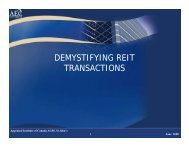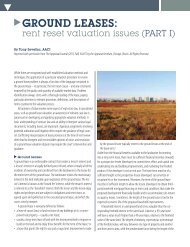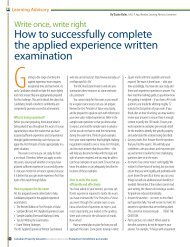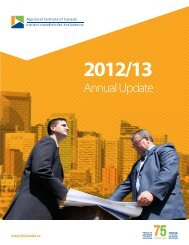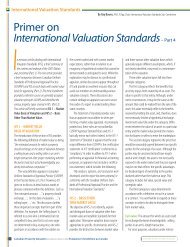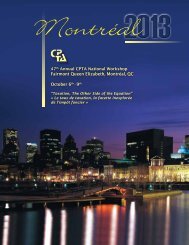Book 2 - Appraisal Institute of Canada
Book 2 - Appraisal Institute of Canada
Book 2 - Appraisal Institute of Canada
Create successful ePaper yourself
Turn your PDF publications into a flip-book with our unique Google optimized e-Paper software.
The ‘tear-down’ trend<br />
By Nicholas N. Rawcliffe, AACI, P. App<br />
Amajor factor in the Greater Vancouver<br />
and Lower Mainland real estate marketplace<br />
<strong>of</strong> British Columbia in the last<br />
five years is the ‘tear-down.’ With ever-increasing<br />
land acquisition and lot creation costs (construction<br />
servicing, municipal fees and consultant<br />
costs), the tear-down builder has emerged from a<br />
minor influence in the dynamics <strong>of</strong> real estate to<br />
a major force shaping the nature <strong>of</strong> competition.<br />
A tear-down is an existing single-family<br />
dwelling on an existing lot (known as a ‘lot-<strong>of</strong>record’)<br />
that is acquired for the specific purpose<br />
<strong>of</strong> tearing down the existing dwelling and then<br />
constructing a new single-family dwelling<br />
within the existing zoning by-law provisions and<br />
allowable building footprint. Under this scenario,<br />
no rezoning or subdivision (with associated<br />
costs) is applicable, and no development cost<br />
charges (DCCs) are payable. No GST is payable<br />
on the purchase, as the acquisition is <strong>of</strong> a ‘used’<br />
existing single-family dwelling. Also, since the<br />
lot-<strong>of</strong>-record exists, no design guidelines are<br />
registered against the title and, thus, there is no<br />
requirement to build to a certain neighbourhood<br />
standard, or no requirement to obtain approval<br />
from a developer’s design consultant as to house<br />
style, house materials or landscaping treatment.<br />
A significant amount <strong>of</strong> residential building<br />
construction costs can be saved by this method<br />
<strong>of</strong> acquisition, assuming the builder opts for<br />
a standard other than what would typically<br />
be prescribed by design guidelines for the<br />
neighbourhood. For these reasons, and in these<br />
particular situations, the existing building does<br />
not contribute utility to the land. The sale price<br />
<strong>of</strong> a tear-down property tends to set the upper<br />
limit <strong>of</strong> value <strong>of</strong> competing similarly-located and<br />
similarly-sized newly-subdivided vacant lots.<br />
This is because, as far as new dwelling size and<br />
design are concerned, the tear-down builder only<br />
has to conform to the setbacks <strong>of</strong> the existing<br />
zoning and, therefore, can build to the maximum<br />
floor area ratio and lot coverage permitted by the<br />
existing zone.<br />
In most cases, the highest and best use continues<br />
to be a single-family residential building<br />
lot. Tear-down situations tend to occur in neighbourhoods<br />
where existing single-family residential<br />
land uses are dominant. It is most noticeable<br />
in areas that are older and well established<br />
with existing infrastructure, and is foremost for<br />
properties fronting arterial roads. This is because<br />
older dwellings are situated fronting arterial<br />
roads, simply because arterial roads were the first<br />
roads constructed in early emerging communities.<br />
This trend is not found in emerging areas or<br />
newly-established neighbourhoods.<br />
Besides the City <strong>of</strong> Surrey, the author has<br />
observed this trend occurring in many other<br />
sub-markets within the Fraser Valley/Greater<br />
Vancouver areas <strong>of</strong> British Columbia, including<br />
Richmond, Vancouver, Burnaby, White Rock, Port<br />
Moody, New Westminster, Coquitlam and Delta.<br />
This trend is not prevalent or applicable to major<br />
housing builders in the residential development<br />
industry, but rather occurs and applies to smaller<br />
builders and ‘end-user builders.’<br />
End-user builders are those participants that<br />
acquire the tear-down, not for the purpose <strong>of</strong><br />
50<br />
Canadian Property Valuation Volume 52 | book 2 | 2008 Évaluation Immobilière au <strong>Canada</strong>



